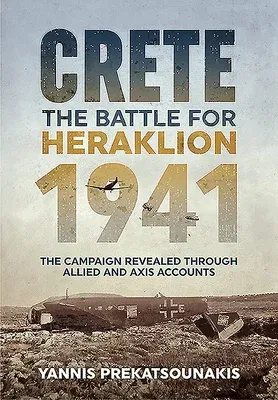Crete, 20 May 1941: the first campaign-sized airborne assault is
launched. Many books have been written about this famous invasion, with
the emphasis mainly on the battles for Maleme and Chania. The Battle for
Heraklion - an epic struggle - remained largely forgotten and widely
unstudied. Yet the desperate fight for Heraklion had everything:
street-fighting in the town; heroic attacks against well-fortified
positions and medieval walls; heavy losses on all sides; and tragic
stories involving famous German aristocratic families like the von
Blüchers and members of the Bismarck family.
This book highlights personal stories and accounts - and the author's
access to records from all three sides allowed accounts to be placed in
their correct place and time. Finally, the history of the battle is
written with the added perspective of extensive Greek accounts and
sources. In contrast, earlier books were based solely on British and
German sources - totally ignoring the Greek side. Many of these accounts
are from people who were fighting directly against each other - and some
reveal what the enemies were discussing and thinking while they were
shooting at or attacking each other. Some accounts are so accurate and
detailed that we can even identify who killed whom. In addition,
long-lost stories behind both well known and previously unpublished
pictures are revealed. For the first time, 75 year-old mysteries are
solved: what were the names of the paratroopers in the planes seen
crashing in famous pictures? What was the fate of soldiers seen in
pictures taken just before the battle? The author has studied the
battlefield in every detail - thus giving the reader the opportunity to
understand actions and incidents by examining what happened on the
actual field of battle. For example, how was it possible for a whole
platoon to be trapped and annihilated, as in the fate of Wolfgang Graf
von Blücher? Such a question is not easily answered even by people with
a military background. How was it possible for the paratroopers to fail
in their attempt to occupy the town? The answers to questions like these
became very clear when the author walked through the battlefields -
following the accounts of the people from all sides who had fought there
and which describe the same incidents.
The author's extensive research is vividly presented via detailed maps
and photographs, both from the era of the battle and today; even
battlefield archaeology plays a role in revealing what really happened
on the battlefield. The author's approach addresses two different types
of readers: those who are largely unfamiliar with the battle - hence the
emphasis on personal stories, accounts and pictures - and the researcher
who wants a reliable source of first-hand material and perhaps a
different point of view, such as is offered by Greek accounts and
sources (and by the writer's detailed analysis of the battle).
This fresh account of one of the Second World War's most memorable
battles is given added authority by the writer's military background,
together with his deep knowledge of the battlefield and his access to
Greek accounts and sources.

